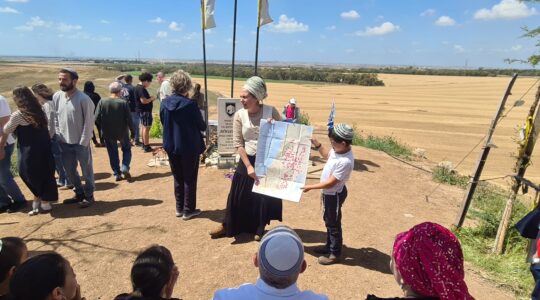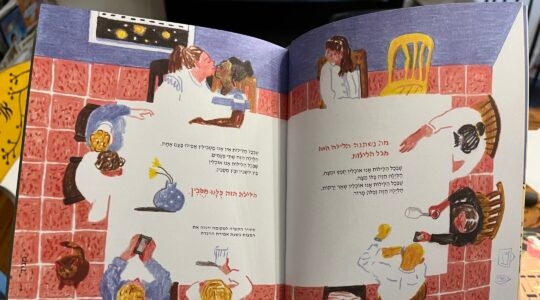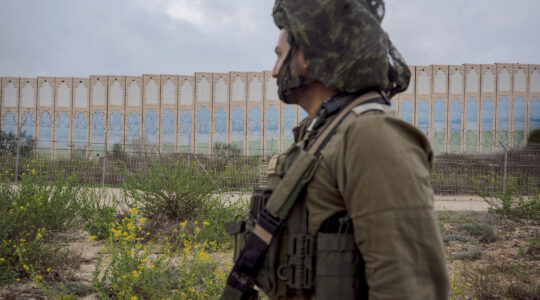RAMALLAH, West Bank (JTA) — The delegation of Israelis who traveled last week to the West Bank headquarters of the Palestinian Authority, the Mukata in Ramallah, consisted mostly of the usual suspects.
There were a few newcomers, such as Israeli tycoon Idan Ofer, but for the most part they were Israeli former officials, academics and activists who often talk about the need to advance the peace process and move toward a two-state solution.
This time, the group was meeting to launch an organization that calls on Israel to conduct negotiations based on the 2002 Arab League peace proposal, which offered the possibility of full diplomatic ties in exchange for Israel’s withdrawal to the pre-1967 border.
Among the Israeli visitors, however, was one unlikely figure: Adina Bar Shalom, the eldest daughter of Rabbi Ovadia Yosef, 92, the longtime spiritual leader of the Sephardic Orthodox Shas Party. Yosef is not known for his fondness for Palestinians. Last summer, he expressed the wish that PA President Mahmoud Abbas and “all those evils will be gone from this world.”
So what was Bar Shalom doing meeting Abbas in Ramallah, the de facto capital of the Palestinian West Bank?
“I’m coming to listen,” Bar Shalom told JTA on the bus ride to Ramallah from Jerusalem. “I wanted to know those on the other side.”
The visit to launch the organization — called Yisrael Yozemet, Hebrew for Israel Initiates — came at an inauspicious time.
Less than a day earlier, Abbas’ Fatah faction and Hamas, the terrorist group that rules the West Bank, announced that they had reached an agreement to reconcile. While some members of the delegation considered canceling the event for fear of public outcry in Israel, Bar Shalom was not among them. And she signed the group’s initiative calling for peace negotiations based on the Arab League’s proposal.
“One can always have second thoughts,” she said. “We figured it was best to go and listen than to give up.”
Asked if she told her father about her plans to go to Ramallah, Bar Shalom said, “I didn’t consult my father before I signed the initiative, but I told him I was going to meet Abu Mazen,” she said, using Abbas’ nom de guerre.
What was her father’s response?
“I got his blessing,” she said.
Bar Shalom is an anachronism. While over the years Shas has moved rightward on the Israeli political map along with most Sephardic Orthodox Jews, Bar Shalom looks to the old days as a model, when Sephardic Orthodoxy went hand in hand with moderate views, including on the Israeli-Arab conflict.
“Thirty years ago my father stood at the stronghold and birthplace of religious Zionism, the Rav Kook Yeshiva in Jerusalem, and said that one drop of Jewish blood isn’t worth the entirety of the territories,” she said of the lands Israel occupied in the 1967 Six-Day War. “At the time, the entire haredi community agreed that we must have peace.”
While her community drifted to the right, Bar Shalom says she kept her old views.
Bar Shalom was born Adina Yosef in 1945 inJerusalem, the first daughter to Yosef and his wife, Margalit. She was a good student and an avid reader. Between helping her mother and taking care of her younger brothers and sisters, she says she read everything: “Jane Eyre,” “Gone with the Wind,” Ayn Rand.
It wasn’t easy living in the shadow of Yosef, a widely respected Sephardic Torah scholar with a growing political following.
“Growing up as child of Rabbi Ovadia Yosef, every one of us children felt like a public figure,” Bar Shalom said.
At 14, despite having excellent grades and against her wishes, Adina was forbidden by her parents to take a scholarship exam that would have allowed her to go to a high school focused on the humanities. Instead, she was sent to study sewing. At age 17, her father introduced her to three men. She was to choose one to be her husband. By 18 she was married.
While her husband, Ezra Bar Shalom, studied in a yeshiva, Bar Shalom opened a bridal salon. After her third daughter was born, the dream of higher education caught up with her again.
“I wanted to study psychology, but my husband said no,” she once told an interviewer for Israel’s Channel 2. “Both my father and my husband didn’t know exactly what was wrong about studying psychology in the university, but they knew it wasn’t right for a Chasidic woman, and they feared it might shake my world.”
Bar Shalom eventually went to study fashion at the Shenkar College of Engineering and Design. This she did with the blessing of her father, who convinced her husband that this was “another form of sewing classes.”
In 2001, again with her father’s support, Bar Shalom started a college to help provide social workers for the Orthodox community. The JerusalemHarediCollege now offers programs in economics, social work, political science and psychology. Men and women study in separate classes.
The college’s establishment came at approximately the same time that Bar Shalom began to express her views in public on social and religious issues. As her renown outside the haredi world grew, she was invited to be part of a committee to help reduce tensions among Israelis of different stripes, and she helped organize encounters between secular and religious Israelis.
Today, Bar Shalom remains something of an enigma. She lives in the tony Tel Aviv neighborhood of Ramat Aviv, a place without a large religious presence. At times she has been criticized in the haredi world for not being sufficiently religious. And unlike many haredi women who cover their hair completely in accordance with strict observance of Jewish law, Adina wears a hat that shows some of her hair.
Yet she remains very much a part of the Sephardic haredi community. She considers herself Orthodox, and she does not question rabbinical authority — least of all her father’s.
For a long time, Bar Shalom worried that openly expressing her political views would jeopardize the college she founded.
“At one point I was approached with an offer to sign the Geneva accord,” she said of an informal, nongovernmental Israeli peace initiative. She demurred.
“I didn’t want to have the public turn away from me at the expense of the college, which was still a work in progress,” she said. “Now there are other people involved in the college, so I can afford it.”
After news spread of her visit last week to Ramallah, a headline in an influential haredi news site, Kikar Hashabat, declared, “Adina Bar Shalom has signed an initiative that supports the return to the ‘67 border.” The article cited an anonymous source at Shas as saying, “No doubt that our Rabbi Ovadia Yosef is not behind this.”
In the peace camp, Bar Shalom’s presence is highly prized.
“She brings us something from a public that is not automatically identified with the peace process,” said a member of Yisrael Yozemet who asked to remain anonymous.
Some in the Israeli left hope that Adina Bar-Shalom’s recent public coming out in support of the two-state solution signifies the re-emergence of “the pragmatic fraction” in Shas, which includes some of the party’s veterans. It’s not yet clear whether or not that’s wishful thinking.
“I still believe that even the current right-wing Shas, if it is presented with a serious peace agreement, will go along with it,” Bar Shalom told JTA.
“People ask me why I do this,” she said. “I have always held these views. It’s the Orthodox public that changed.”
Before leaving the Mukata last week, Abbas paused and turned to Bar Shalom.
“I want to congratulate the daughter of Rabbi Ovadia,” he said, asking her to tell her father that “we believe in peace.”
Later, after sitting down to lunch with Palestinian officials in a session that was closed to members of the media, Bar Shalom sounded an optimistic note.
“I’m happy I came,” she said, marching back toward the bus. “I feel that we have a partner. I don’t know for sure, but I feel it. And I will tell this to my father.”
JTA has documented Jewish history in real-time for over a century. Keep our journalism strong by joining us in supporting independent, award-winning reporting.





